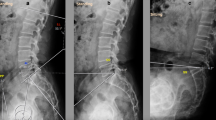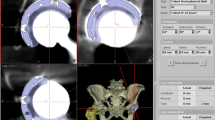Abstract
Accurate acetabular cup position remains a persistent challenge in total hip arthroplasty (THA). Studies investigating the early outcomes of robotic-assisted THA (RA-THA) systems have shown improved cup placement compared to manual THA (mTHA) approaches, however, contemporary robotic platforms are reliant on pre-operative CT imaging. The goal of this study was to analyze the accuracy of a novel, fluoroscopy-based RA-THA system compared to an unassisted mTHA approach and determine the effect of the robotic system on operative time. We performed a retrospective cohort analysis on a consecutive series of 198 patients who received mTHA and RA-THA between March 2021 and July 2022. The primary outcome of interest was the accuracy of acetabular component placement, defined by average cup inclination and anteversion. Secondary outcomes included the proportion of acetabular cups positioned within the Lewinnek safe zone, operative time, and overall room time. The RA-THA group demonstrated significantly higher accuracy of acetabular anteversion to target compared to the manual group (18.5 vs. 21.7˚; p < 0.001), and had a significantly greater proportion of acetabular cups placed within the Lewinnek safe zone (81.6 vs. 59.0%; p < 0.001). The RA-THA cohort had longer operative times compared to mTHA group (39.0 vs. 35.3 min; p = 0.003), but no difference was seen in total operating room time (101.2 vs. 101.2 min; p = 0.982). This study demonstrates that the use of a novel, fluoroscopy-based, pin-less THA robotic platform increased the accuracy of acetabular cup placement, including a 22.6% improvement in safe zone placement, compared to mTHA approach, with no increase in overall case time.



Similar content being viewed by others
Data availability
The data used to support the findings of this study are available from the corresponding author upon request.
References
Abdel MP, von Roth P, Jennings MT, Hanssen AD, Pagnano MW (2016) What safe zone? The vast majority of dislocated THAs are within the Lewinnek safe zone for acetabular component position. Clin Orthop Relat Res 474:386–391
Anon. American Joint Replacement Registry (AJRR): 2020 Annual Report. Rosemont, IL; 2020.
Beyer F, Lützner C, Stalp M, Köster G, Lützner J (2022) Does the use of patient-specific instrumentation improve resource use in the operating room and outcome after total knee arthroplasty? A multicenter study. PLoS ONE 17:e0277464
Biedermann R, Tonin A, Krismer M, Eibl G, Stöckl B (2005) Reducing the risk of dislocation after total hip arthroplasty: the effect of orientation of the acetabular component. J Bone Joint Surg Br 87:762–769
Chen X, Xiong J, Wang P, Zhu S, Qi W, Peng H, Yu L, Qian W (2018) Robotic-assisted compared with conventional total hip arthroplasty: systematic review and meta-analysis. Postgrad Med J 94:335
Clement ND, Gaston P, Bell A, Simpson P, Macpherson G, Hamilton DF, Patton JT (2021) Robotic arm-assisted versus manual total hip arthroplasty: a propensity score matched cohort study. Bone Joint Res 10:22
Danoff JR, Bobman JT, Cunn G, Murtaugh T, Gorroochurn P, Geller JA, Macaulay W (2016) Redefining the acetabular component safe zone for posterior approach total hip arthroplasty. J Arthroplasty 31:506–511
Domb BG, Chen JW, Lall AC, Perets I, Maldonado DR (2020) Minimum 5-year outcomes of robotic-assisted primary total hip arthroplasty with a nested comparison against manual primary total hip arthroplasty: a propensity score-matched study. J Am Acad Orthop Surg 28:847–856
Dorr LD, Callaghan JJ (2019) Death of the Lewinnek “Safe Zone.” J Arthroplasty 34:1–2
Emara AK, Samuel LT, Acuña AJ, Kuo A, Khlopas A, Kamath AF (2021) Robotic-arm assisted versus manual total hip arthroplasty: systematic review and meta-analysis of radiographic accuracy. Int J Med Robot 17:e2332
Emara AK, Zhou G, Klika AK, Koroukian SM, Schiltz NK, Higuera-Rueda CA, Molloy RM, Piuzzi NS (2021) Is there increased value in robotic arm-assisted total hip arthroplasty? A nationwide outcomes, trends, and projections analysis of 4,699,894 cases. Bone Joint J 103-B:1488–1496
Grammatopoulos G, Thomas GER, Pandit H, Beard DJ, Murray DW, Gill HS (2015) The effect of orientation of the acetabular component on outcome following total hip arthroplasty with small diameter hard-on-soft bearings. Bone Joint J 97-B:164–172
Guo D, Li X, Ma S, Zhao Y, Qi C, Xue Y (2022) Total hip arthroplasty with robotic arm assistance for precise cup positioning: a case-control study. Orthop Surg 14:1498–1505
Honl M, Dierk O, Gauck C, Carrero V, Lampe F, Dries S, Quante M, Schwieger K, Hille E, Morlock MM (2003) Comparison of robotic-assisted and manual implantation of a primary total hip replacement. A prospective study. J Bone Joint Surg Am 85:1470–1478
Kamara E, Robinson J, Bas MA, Rodriguez JA, Hepinstall MS (2017) Adoption of robotic vs fluoroscopic guidance in total hip arthroplasty: is acetabular positioning improved in the learning curve? J Arthroplasty 32:125–130
Kamath AF, Durbhakula SM, Pickering T, Cafferky NL, Murray TG, Wind MA, Méthot S (2021) Improved accuracy and fewer outliers with a novel CT-free robotic THA system in matched-pair analysis with manual THA. J Robot Surg. https://doi.org/10.1007/s11701-021-01315-3
Kort N, Stirling P, Pilot P, Müller JH (2021) Clinical and surgical outcomes of robot-assisted versus conventional total hip arthroplasty: a systematic overview of meta-analyses. EFORT Open Rev 6:1157
Kunze KN, Bovonratwet P, Polce EM, Paul K, Sculco PK (2022) Comparison of surgical time, short-term adverse events, and implant placement accuracy between manual, robotic-assisted, and computer-navigated total hip arthroplasty: a network meta-analysis of randomized controlled trials. J Am Acad Orthop Surg Glob Res Rev. https://doi.org/10.5435/JAAOSGlobal-D-21-00200
Lim S-J, Ko K-R, Park C-W, Moon Y-W, Park Y-S (2015) Robot-assisted primary cementless total hip arthroplasty with a short femoral stem: a prospective randomized short-term outcome study. Comput Aided Surg 20:41–46
Maldonado DR, Go CC, Kyin C, Rosinsky PJ, Shapira J, Lall AC, Domb BG (2021) Robotic arm-assisted total hip arthroplasty is more cost-effective than manual total hip arthroplasty: a Markov model analysis. J Am Acad Orthop Surg 29:e168–e177
Nakamura N, Sugano N, Nishii T, Kakimoto A, Miki H (2010) A comparison between robotic-assisted and manual implantation of cementless total hip arthroplasty. Clin Orthop Relat Res 468:1072
Ng N, Gaston P, Simpson PM, Macpherson GJ, Patton JT, Clement ND (2021) Robotic arm-assisted versus manual total hip arthroplasty : a systematic review and meta-analysis. Bone Joint J. 103-B:1009–1020
Pierce J, Needham K, Adams C, Coppolecchia A, Lavernia C (2021) Robotic-assisted total hip arthroplasty: an economic analysis. J Comp Eff Res 10:1225–1234
Remily EA, Nabet A, Sax OC, Douglas SJ, Pervaiz SS, Delanois RE (2021) Impact of robotic assisted surgery on outcomes in total hip arthroplasty. Arthroplast Today 9:46–49
Stewart NJ, Stewart JL, Brisbin A (2022) A comparison of component positioning between fluoroscopy-assisted and robotic-assisted total hip arthroplasty. J Arthroplasty 37:1602-1605.e3
Sugano N (2013) Computer-assisted orthopaedic surgery and robotic surgery in total hip arthroplasty. Clin Orthop Surg 5:1
Sweet MC, Borrelli GJ, Manawar SS, Miladore N (2021) Comparison of outcomes after robotic-assisted or conventional total hip arthroplasty at a minimum 2-year follow-up: a systematic review. JBJS Rev. https://doi.org/10.2106/JBJS.RVW.20.00144
Tompkins GS, Sypher KS, Li HF, Griffin TM, Duwelius PJ (2021) Robotic vs manual total knee arthroplasty in high volume surgeons: a comparison of cost and quality metrics. J Arthroplasty. https://doi.org/10.1016/j.arth.2021.12.018
Funding
The authors declare that no funds, grants, or other support were received during the preparation of this manuscript.
Author information
Authors and Affiliations
Contributions
All authors contributed to the study conception and design. Material preparation, data collection and analysis were performed by GBJB and CJH. The first draft of the manuscript was written by GBJB and all authors commented on previous versions of the manuscript. All authors read and approved the final manuscript.
Corresponding author
Ethics declarations
Conflict of interest
GBJB and CJH declare they have no competing interests. DK serves on the speakers’ bureau and receives royalties from Zimmer Biomet. DL serves on the speakers’ bureau, is a paid consultant, and receives royalties and research support from Zimmer Biomet. LM is a paid consultant and receives research support from Zimmer Biomet. AFK serves on the speakers’ bureau, is a paid consultant, and owns stock or stock options in Zimmer Biomet.
Ethical approval
This study was performed in line with the principles of the Declaration of Helsinki. Approval was granted by the Cleveland Clinic Foundation Institutional Review Board (June 3rd, 2022/ No. 22-528).
Additional information
Publisher's Note
Springer Nature remains neutral with regard to jurisdictional claims in published maps and institutional affiliations.
Rights and permissions
Springer Nature or its licensor (e.g. a society or other partner) holds exclusive rights to this article under a publishing agreement with the author(s) or other rightsholder(s); author self-archiving of the accepted manuscript version of this article is solely governed by the terms of such publishing agreement and applicable law.
About this article
Cite this article
Buchan, G.B.J., Hecht, C.J., Liu, D. et al. Improved accuracy of a novel fluoroscopy-based robotically assisted THA system compared to manual THA. J Robotic Surg 17, 2073–2079 (2023). https://doi.org/10.1007/s11701-023-01623-w
Received:
Accepted:
Published:
Issue Date:
DOI: https://doi.org/10.1007/s11701-023-01623-w




